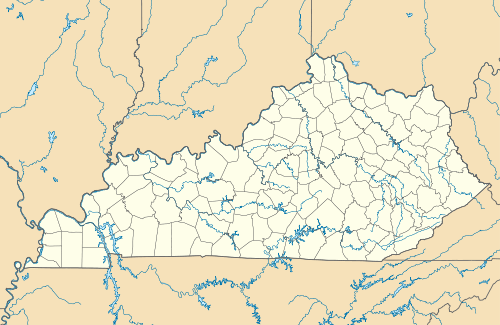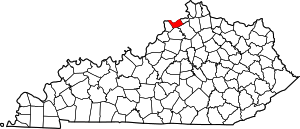Ghent, Kentucky
Ghent is a home rule-class city along the south bank of the Ohio River in Carroll County, Kentucky, in the United States. The population was 323 at the 2010 census.[3]
Ghent, Kentucky | |
|---|---|
City | |
 Location of Ghent in Carroll County, Kentucky. | |
 Ghent Location of Ghent in Kentucky  Ghent Ghent (the United States) | |
| Coordinates: 38°44′10″N 85°3′37″W | |
| Country | |
| State | |
| County | Carroll |
| Named for | The site of the treaty ending the War of 1812 |
| Area | |
| • Total | 0.72 sq mi (1.86 km2) |
| • Land | 0.71 sq mi (1.84 km2) |
| • Water | 0.01 sq mi (0.01 km2) |
| Elevation | 486 ft (148 m) |
| Population (2010) | |
| • Total | 323 |
| • Estimate (2019)[2] | 305 |
| • Density | 428.97/sq mi (165.59/km2) |
| Time zone | UTC-5 (Eastern (EST)) |
| • Summer (DST) | UTC-4 (EDT) |
| ZIP code | 41045 |
| Area code(s) | 502 |
| FIPS code | 21-30808 |
| GNIS feature ID | 0492798 |
Geography
Ghent is located in northeastern Carroll County at 38°44′10″N 85°3′37″W (38.736116, -85.060225),[4] along the Ohio River. According to the United States Census Bureau, the city has a total area of 0.73 square miles (1.9 km2), all land.[3] The community is located on U.S. Route 42 at Kentucky Route 47. Ghent is north of Interstate 71.
Ghent is on the opposite side of the Ohio River from Vevay, Indiana, but the towns are not linked by a bridge. Ferry service between these two river cities spanned 175 years from 1802 to 1977.
History
Ghent was settled at the end of eighteenth century and was first known as McCool's Creek Settlement.[5] The town was laid out in 1814.[6] Henry Clay is alleged to have suggested the name,[6] derived from the city of Ghent (then part of the Netherlands and now part of Belgium), where the treaty ending the War of 1812 was signed between the United States and the United Kingdom on Christmas Eve, 1814.[7] Ghent's post office opened in 1816. On January 17, 1839, the Kentucky General Assembly formally established the city of Ghent and appointed Theodoric Fisher, Samuel Sanders Jr., James Knox, John C. Lindsey, and Richard Sarlls as its trustees.[8]
In August 1864, in a skirmish during the Civil War in what was known as the Gex Landing Incident, members of the African-American United States Colored Troops and the United States Colored Cavalry engaged with CSA troops seeking to rescue local resident James Southard, a ferryman and Confederate sympathizer who had been arrested. USCT soldiers suffered an undetermined number of casualties.[9]
Demographics
| Historical population | |||
|---|---|---|---|
| Census | Pop. | %± | |
| 1860 | 366 | — | |
| 1870 | 464 | 26.8% | |
| 1880 | 387 | −16.6% | |
| 1890 | 525 | 35.7% | |
| 1900 | 569 | 8.4% | |
| 1910 | 421 | −26.0% | |
| 1920 | 438 | 4.0% | |
| 1930 | 383 | −12.6% | |
| 1940 | 414 | 8.1% | |
| 1950 | 368 | −11.1% | |
| 1960 | 342 | −7.1% | |
| 1970 | 385 | 12.6% | |
| 1980 | 439 | 14.0% | |
| 1990 | 365 | −16.9% | |
| 2000 | 371 | 1.6% | |
| 2010 | 323 | −12.9% | |
| Est. 2019 | 305 | [2] | −5.6% |
| U.S. Decennial Census[10] | |||
As of the census[11] of 2000, there were 371 people, 125 households, and 103 families residing in the city. The population density was 517.4 people per square mile (198.9/km2). There were 152 housing units at an average density of 212.0 per square mile (81.5/km2). The racial makeup of the city was 89.49% White, 5.93% African American, 3.50% from other races, and 1.08% from two or more races. Hispanic or Latino of any race were 6.20% of the population.
There were 125 households, out of which 36.0% had children under the age of 18 living with them, 56.8% were married couples living together, 15.2% had a female householder with no husband present, and 17.6% were non-families. 14.4% of all households were made up of individuals, and 6.4% had someone living alone who was 65 years of age or older. The average household size was 2.97 and the average family size was 3.17.
In the city, the population was spread out, with 27.8% under the age of 18, 8.4% from 18 to 24, 29.1% from 25 to 44, 21.8% from 45 to 64, and 12.9% who were 65 years of age or older. The median age was 34 years. For every 100 females, there were 102.7 males. For every 100 females age 18 and over, there were 94.2 males.
The median income for a household in the city was $37,917, and the median income for a family was $39,028. Males had a median income of $32,031 versus $17,813 for females. The per capita income for the city was $17,106. About 8.6% of families and 12.8% of the population were below the poverty line, including 22.0% of those under age 18 and 3.0% of those age 65 or over.
Climate
The climate in this area is characterized by hot, humid summers and generally mild to cool winters. According to the Köppen Climate Classification system, Ghent has a humid subtropical climate, abbreviated "Cfa" on climate maps.[12]
Notable people
- Edwin Otway Burnham (1824–1873), a rifle-shooting Presbyterian missionary who moved to Sioux Indian territory and who was said could bark a squirrel, swing an axe or dispense Gospel with equal fervor and efficiency.[13] His father, Dr. Frederick Burnham, had moved to Ghent to recover from injuries he sustained in the War of 1812.[14]
- Nancy Diuguid (1948-2003), daughter of tobacco farmer Gex Lillard Diuguid and Elizabeth Lineback, was a globally active theatre director who worked in England and South Africa. She grew up in Ghent.
See also
- List of cities and towns along the Ohio River
References
- "2019 U.S. Gazetteer Files". United States Census Bureau. Retrieved July 24, 2020.
- "Population and Housing Unit Estimates". United States Census Bureau. May 24, 2020. Retrieved May 27, 2020.
- "Geographic Identifiers: 2010 Demographic Profile Data (G001): Ghent city, Kentucky". U.S. Census Bureau, American Factfinder. Archived from the original on February 12, 2020. Retrieved August 7, 2014.
- "US Gazetteer files: 2010, 2000, and 1990". United States Census Bureau. 2011-02-12. Retrieved 2011-04-23.
- Kentucky Atlas. "Ghent".
- Rennick, Robert M. (1987). Kentucky Place Names. University Press of Kentucky. p. 115. Retrieved 28 April 2013.
- Lewis Collins (1877). History of Kentucky. p. 118.
- Acts of the General Assembly of the Commonwealth of Kentucky. December Session, 1838, p. 40.
- Tenkotte, Paul and Claypool, James. The Encyclopedia of Northern Kentucky. University Press of Kentucky, 2015, pages 396-398.
- "Census of Population and Housing". Census.gov. Retrieved June 4, 2015.
- "U.S. Census website". United States Census Bureau. Retrieved 2008-01-31.
- "Ghent, Kentucky Köppen Climate Classification (Weatherbase)". Weatherbase.
- McClintock, Rev. John, ed. (1885). Cyclopedia of Biblical, theological, and ecclesiastical literature: Vol 1 A-CN. Harper & Brothers. p. 692.
Burnham, Edwin Otway, a Congregational minister, was born in Ghent, Ky, in 1824. He Graduated at Hamilton College, N.Y., in 1852, and was a student at Union Theological Seminary for three years. From 1855 to 1856 he was a teacher at Pennington, N.J. In 1858 he was ordained, after having been stated supply at Columbus, Iowa, in 1856, and at Wilton, Minn., in 1857. At Tivoli he also served as stated supply. From 1871 to 1873 he was an invalid, in California. He died at Los Angeles, Cal., Aug. 1, 1873. See Gen. Cat. of Union Theol. Sem. 1876, p.74.
- Burnham, Roderick Henry (1884). Genealogical Records of Thomas Burnham, the Emigrant, who was Among the Early Settlers at Hartford, Connecticut, U.S. America, and His Descendants. Hartford, CT: Case, Lockwood & Brainard Co.
